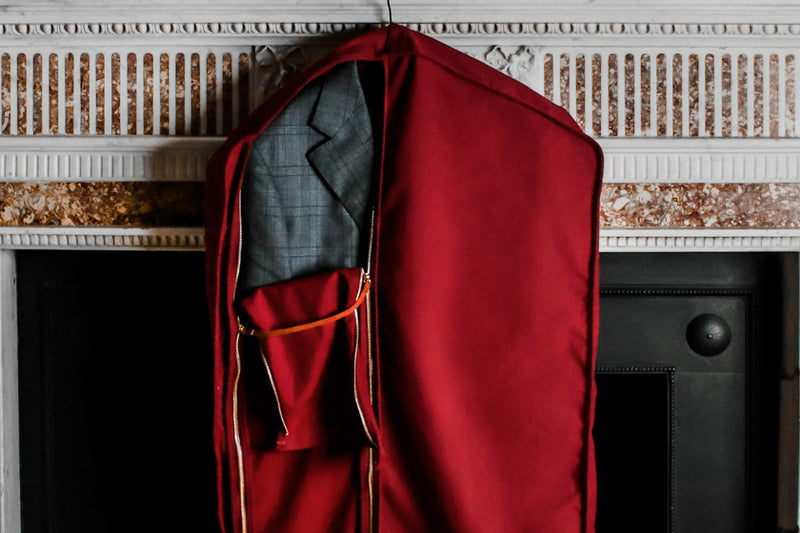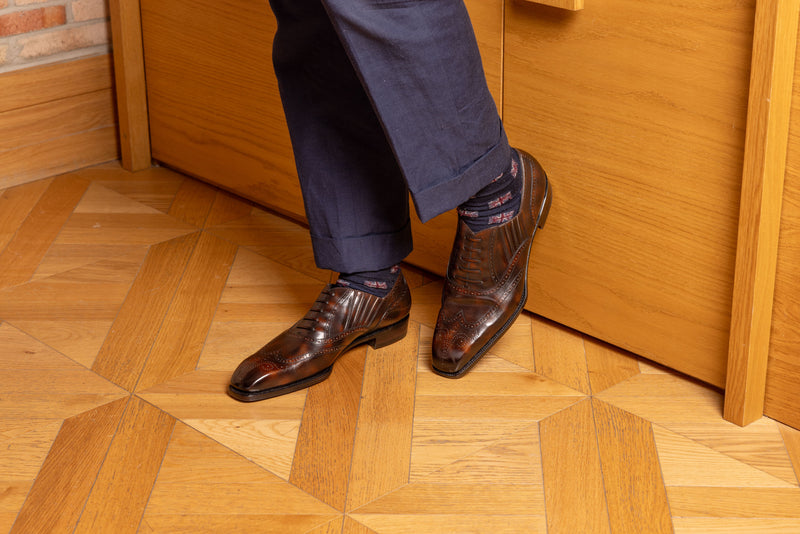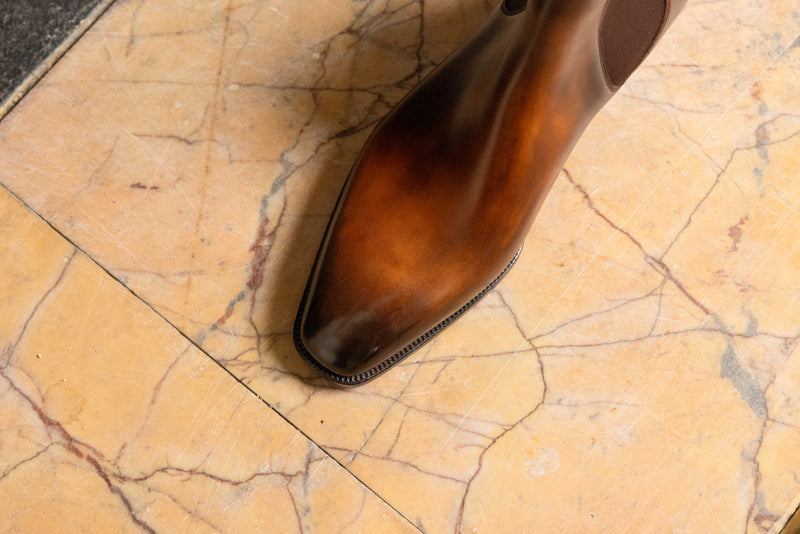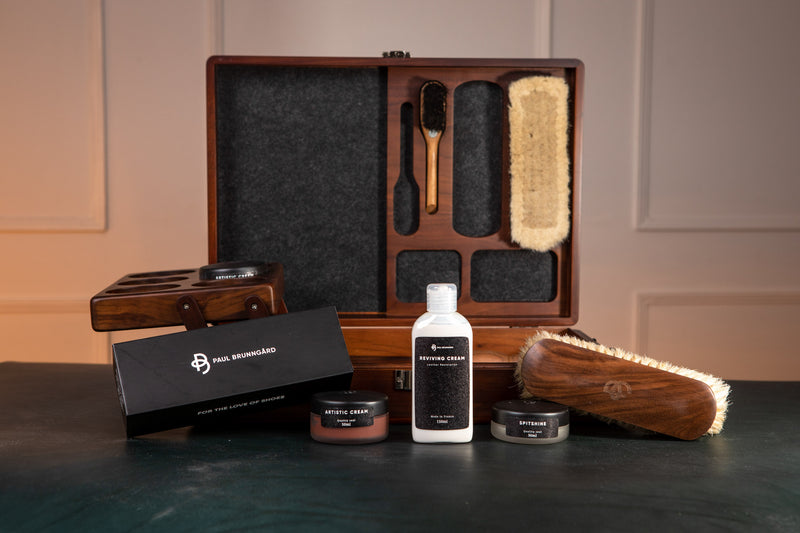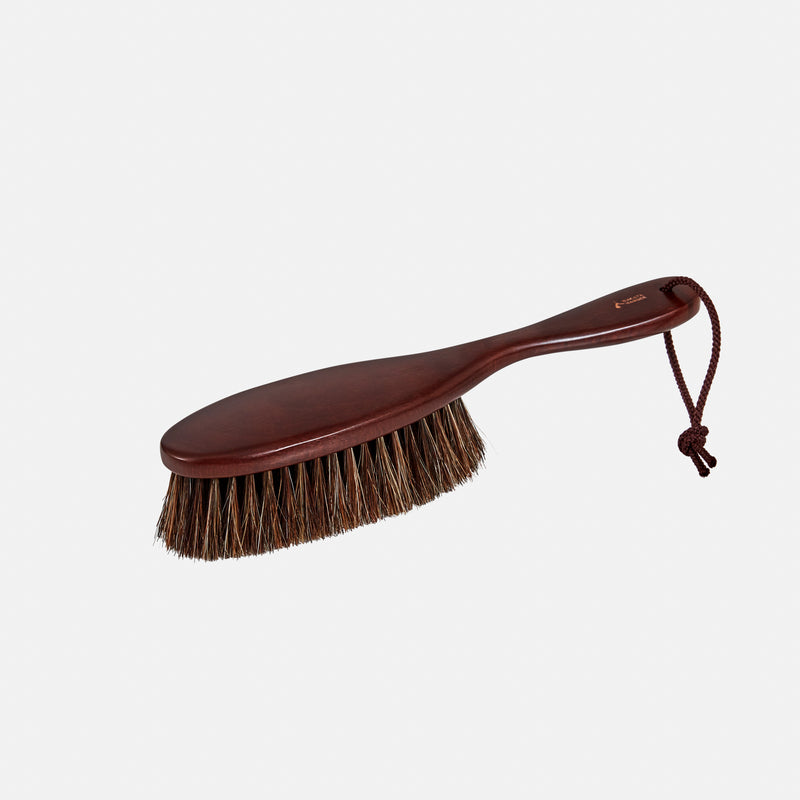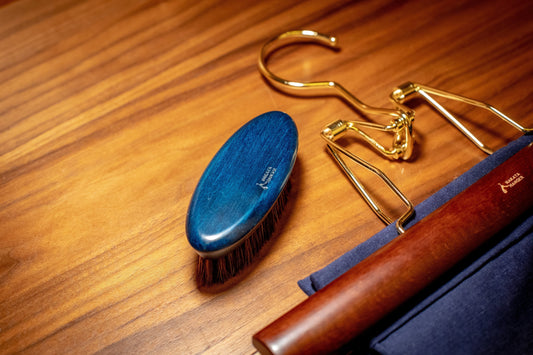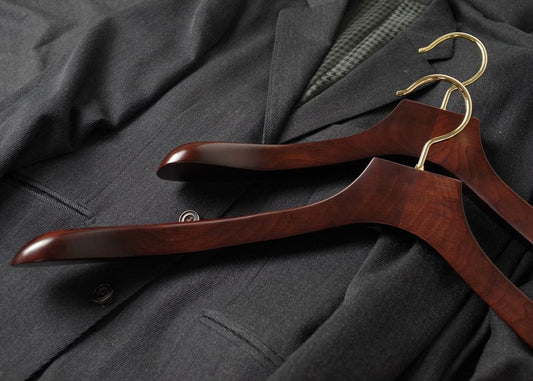It's not always obvious how suits or tailoring wear should be maintained, stored and cleaned. It was once common to receive advice by word of mouth -- be it from from one's father or the tailor. In this article, we break suiting care into two major parts: (i) storage and (ii) cleaning.
1. Always hang your jackets on a hanger when you are not wearing it. Of course, there are a number of goods reasons (e.g. organisation) for doing so, but in terms of function with respect to your clothing, there are two primary reasons: firstly, it allows your garments to retain a shape that avoids wrinkles and does not produce stress in the wrong areas. In this way, crunching up your jacket and throwing it on a chair is probably not a good idea. The second, often overlooked reason, is that it allows for your garments to ventilate. When a garment is worn, moisture will inevitably be absorbed by the cloth. It is imperative to let the cloth dry by way of ventilation. This is why experts often suggest cycling through your suits to wear.
As for trousers, they can be draped over the trouser bar of the hanger (if it has one), draped over a trouser hanger, or clipped upside down from a trouser clamp. Indeed, some swear by the trouser clamp, as it’s been thought to avoid the horizontal crease in the middle of the trousers. But I personally find that larger diameter trouser bars mitigate this anyways.
Quick tip: When out and about, if it’s not possible to find a hanger for your jacket, don’t be tempted to hang it over the back of your chair. God forbid. This will not do any good to the shoulders. Instead, if you must, fold it in half on the long side and gently place flat somewhere out of danger. And as for trousers, try to keep them on – at least, until you get home.
How to choose a hanger:
As far as we are concerned, there is only two factors here: make sure that your hangers are appropriately shaped and appropriately sized. This means that you are not using a thin shirt hanger on jackets and that the bulb of the hanger is contoured nicely. Secondly, your hanger is neither too wide nor too narrow for your jacket. In either case, damage can be done to the shoulders of the jacket. As a rough guideline, if your jacket size is 40-42, your hangers should be 17-17.5” wide.
Whilst the shape is most important for ergonomic function and fit, the material of the hanger will matter for longevity and aesthethic purposes. A harder grain wood such as Beechwood will last longer, and also permit a finer finish (either through sanding or planing) which preserves the grain of the wood. On some high-end highers, one can visibly see the grain of the wood.
We have heard folks from Savile Row bringing up the point that a wooden hanger can also absorb moisture from the shoulders of the jacket. They cite Beechwood and Cedar as being most absorbent. Whether this is true is hard to determine. However, what is certain is that a strong curve to emulate a natural human positure will create room within the jacket when hung, which, in turns, increases breathability. Breathability is important for long-lasting garments.
Image. 1 Top-Down View of the Nakata AUT-03. Notice the shape, especially when compared to an ordinary hanger.
2. Always store in breathable garment bags. They help protect your suits from moths, humidity, and dust. Even the cheaper polyester ones are better than nothing. Pesty moths can damage fabrics, they are particularly drawn to certain fabrics, such as cashmere and silk – and grotesquely, human hair.
Importantly, make sure that the garment bag is breathable. As mentioned, some moisture will inevitably be absorbed by the cloth during wear. It is imperative to be able to air the cloth out to ensure that your suits last as long as they can.
And so, be wary about clear PVC plastic garment bags. Whilst they may keep moths out, the plastic is not breathable at all. Moreover, I find that clear PVC can yellow over time and transfer over to the cloth – yuck!
Part II: Cleaning
1. It’s always a good idea to brush your garments upon returning home. This removes dust, dirt, and debris.
There are good brushes to be had anywhere. Brushes differ by stiffness of the fibres. More delicate clothing fabrics and/or weaves require softer brushes. For example, a hard bristled brush should never be used on a cashmere hopsack summer jacket – it will just increase the pilling.
2a. Avoid dry-cleaning. The dry cleaning of suits, I would say is a modern (American?) myth that, unfortunately, not everyone is aware. Dry-cleaning does very little for removing human moisture, which is the ordinary reason for cleaning one’s suit. And, the harsh chemicals associated with dry cleaning hurts the fibre’s sheen. Other than a particular bad case of soiling that require harsher chemical attention, there are seldom occasions that call for dry cleaning.
Our partners at Clothes Doctor advises on washing any clothes, for that matter, as little as possible.
2b. Instead, one should “Sponge and Press”. The damp sponge helps remove human moisture from the cloth and the pressing helps restore the three-dimensional shape that a jacket ought to have. Note that the lapel roll is a function of many things, including the degree of hand padding, construction, as well as the pressing. The issue is that pressing a jacket is a particularly technical skill that is best done by a professional – e.g. a tailor or someone who knows that they are doing.
Simon Crompton has written a very good article on this.
Note aside: if anyone has seen North By Northwest, then you might recall the famous Crop Duster Scene. Here, Cary Grant runs through the field in his bespoke gray suit – the only outfit he wears throughout the whole film. But in this attempt to evade danger, he inevitably soils this suit turning it from gray to brown. Miraculously, after a good Sponge and Press at the hotel to which he returns, the suit looks impeccable again.
3. It is permissible to regularly hand-wash your trousers with a gentle cashmere/wool shampoo. Common makes are The Laundress and the Clothes Doctor washes -- we stock the latter, as they are made in Britain.

Since we wear collared shirts under the jacket, human moisture usually does not get absorbed by the jacket’s cloth. However, the same cannot be said for the trousers. Often, after two or three wears, I can start to feel uncomfortable in trousers.
To clean your trousers, turn your trousers inside out and soak them in luke-warm water with the cashmere/wool wash which has been formulated especially for . Gently massage the garment to release sweat. I previously used products from the Laundress, but I now use Clothes Doctor, as I find it gentler. Air dry (flat) and then press whilst damp.
But if you regularly hand wash your trousers but not your jacket, wouldn’t there be differential aging of the fabric between the two? This is certainly true and somewhat unfortunate. But, on the other hand, I find it incredibly impractical to not wash my trousers. Do you really want to wear sweaty trousers? This is one of those things in life where there is tension between practicality and the unobtainable ideal.
Nonetheless, I find that one way to mitigate this is to have two trousers for every suit, and then alternate them every other wear
Table 1. How often to clean suits?
| After every wear: | Brush the jacket and trousers after every wear. Start by brushing at the top near the collar and shoulders. Spot clean using a clean damp cloth or sponge if necessary. |
| After every ten to twenty wears: | “Sponge and Press”. (Not too surprisingly, but when I’m in Hong Kong, I tend to sponge and press at a rate closer to the lower end of that range than when I am in London.) |
| After every forty to sixty wears: | Dry clean, if desired. |
4. Be careful with steamers
Steamers are often useful for dresses and trousers but be very careful when using with jackets. This is because jackets have a canvas, which are either floating or fused. In the case of a fused canvas, the steam may cause the glue to weaken and cause puckering around the jacket front and lapel.
I don’t believe that this is an issue in non-fused jackets – although opinion seems to be divided. I suspect steam would help loosen some of the debris from the fibres, which when combined with some light brushing, makes for a wonderful cleaning routine. And, once the garment is dried, the cloth should return to its natural crisp feel, without any puckering.
There is, however, so much variability with respect to clothes and construction that I am not sure that the above advice holds true universally. I often find that when people disagree about a subject matter, it is because they aren’t holding the relevant variables fixed. Perhaps, puckering occurs only under XYZ conditions. As to what those conditions are, exactly, I am afraid that I have no answer.

